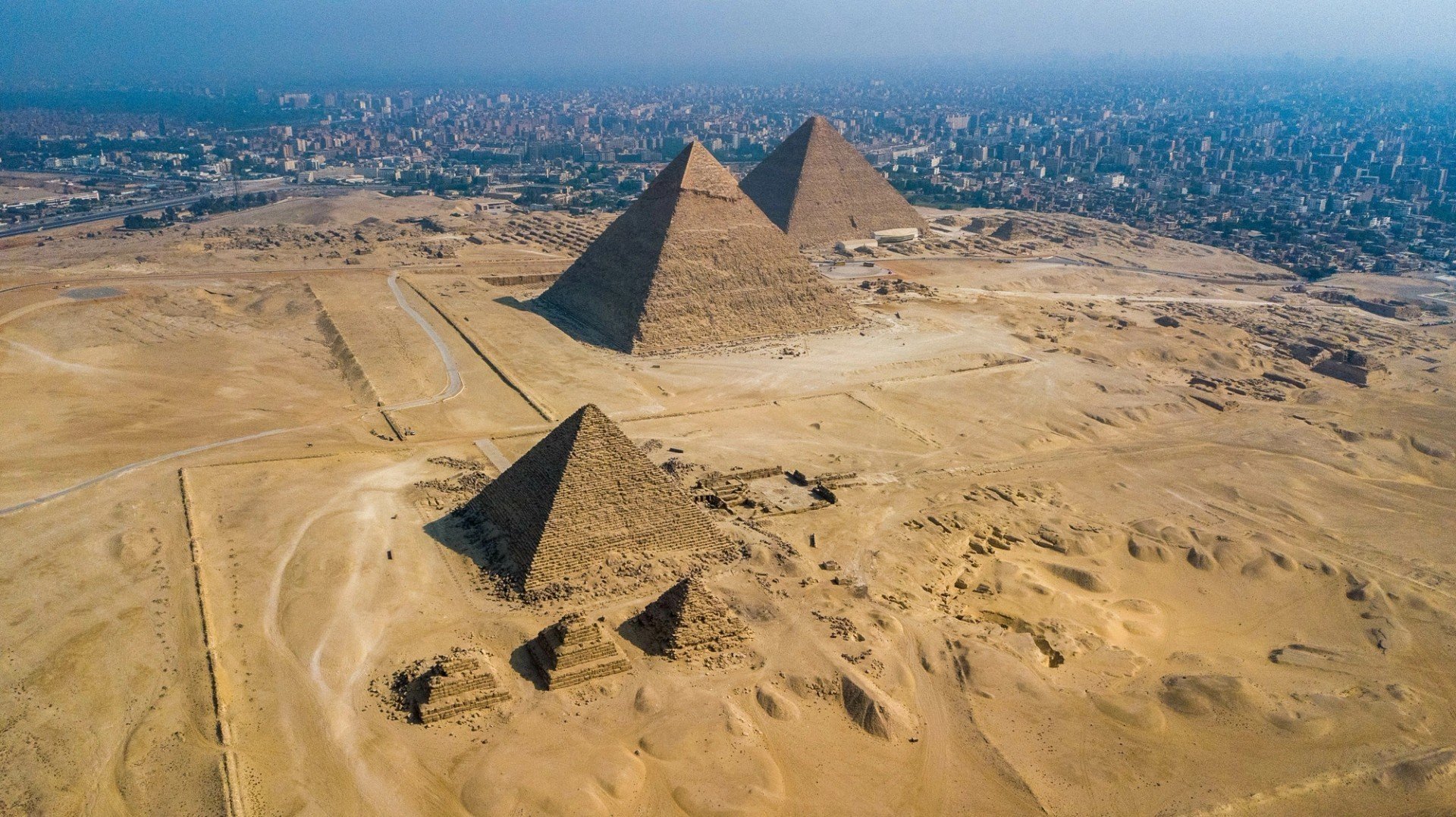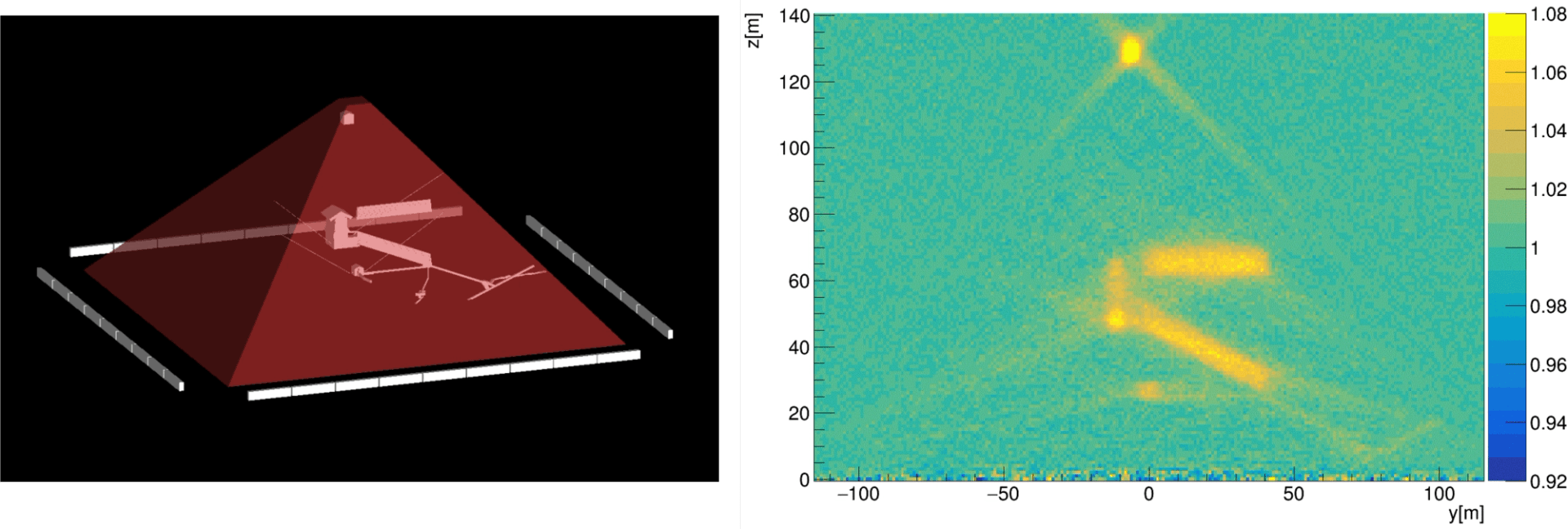Muon Telescope Developed at Fermilab Could Unlock Mysteries of the Great Pyramid of Giza
At the APS April Meeting, researchers discussed their plans to use fundamental particles to peer inside a wonder of the ancient world.

In 1968, American physicist Luis Walter Alvarez traveled to the sun-scorched desert of Egypt on a quest to discover hidden chambers inside one of the greatest structures ever built, the pyramid of Khafre. But Alvarez wasn’t excavating with shovels or picks. Instead, his tool of choice was a fundamental particle—the muon.
Produced by the interaction of cosmic rays with Earth’s atmosphere, muons—similar to electrons, but about 200 times heavier—rain from the sky at nearly the speed of light, with enough energy to penetrate even the densest, largest structures.
Alvarez reasoned that muons traveling through the pyramid would be affected by what they encountered on the way. Muons that transited the pyramid’s limestone walls would be stopped or deflected, or strike the detector with only a fraction of their energy left—but muons passing through empty spaces, like the pharaoh’s burial chamber, would whiz straight through. So Alvarez set up a special muon detector in the pyramid’s base and began collecting data.
Unfortunately, he didn’t find much. But his work inspired new efforts to use muons to “see” inside volcanoes, nuclear reactors, and, of course, other pyramids.
At the APS April Meeting in Minneapolis, Ralf Ehrlich, a researcher at the University of Virginia, discussed plans to use a “muon telescope” to map the entire 454-foot-tall Great Pyramid of Giza, built by the pharaoh Khufu. Sitting next to Khafre’s pyramid, the Great Pyramid is the tallest pyramid on Earth. Muons detected from different locations and directions will be combined to generate a single 3D reconstruction—similar to tomographic imaging, used in medical CT scanners.
“The idea first came to me when I visited Egypt in 2010 and I spent a day on the Giza plateau,” says Alan Bross, a senior scientist at Fermilab in Illinois and project lead on the work that Ehrlich presented. He knew the Great Pyramid was big, but in person, “it was just amazing.” At that time, Bross was studying cosmic-ray muon imaging for cargo container inspection.
Back home, Bross couldn’t shake the pyramid from his mind. He reached out to an expert on the Giza pyramids, Mark Lehner of the Institute for the Study of Ancient Cultures (formerly, the Oriental Institute) at the University of Chicago. The duo slowly explored the idea. In 2017, when another team reported the discovery of a massive chamber close to the center of the Great Pyramid, Lehner asked Bross whether Fermilab could do a follow-up study to verify the finding.
Bross assembled a team and, in early 2018, received approval from the Egyptian Ministry of Antiquities to carry out the “Exploring the Great Pyramid” project. In 2019, the University of Chicago’s Big Ideas Generator awarded Bross $150,000 to develop the muon telescope, and Fermilab matched the funds.
By then, Bross was leading a new muon-based research program at Fermilab, known as Mu2e, short for “muon to electron conversion,” to explore the physics of the muon decay process. Ehrlich was focused on Mu2e’s cosmic ray veto detector, whose design Bross planned to use in the new muon telescope. Bross tapped Ehrlich for help.
Cosmic-ray muons with kinetic energies of 10 to 200 GeV before reaching the pyramid will provide optimal data for analysis, says Ehrlich. That’s because a muon can be elastically scattered by interactions with large atomic nuclei, like those of the calcium atoms in the pyramids’ limestone walls; higher-energy muons are less affected by elastic scattering, while low-energy muons often don’t make it through at all.
The telescope will be constructed of eight muon detectors, housed in two-by-two arrays inside two temperature-controlled cargo containers. To collect the data needed to reconstruct a full 3D model of the Great Pyramid’s interior, the team will position both detector arrays to face the pyramid for about one-and-a-half months, before moving the setup to a new location and repeating. The team estimates that a full scan will take about two years.
Then, the datasets from each location will be combined to reconstruct the complete 3D image—and possibly reveal new structures inside the pyramid, says Ehrlich.

“I was extremely excited to hear that they wanted to undertake this effort,” says Los Alamos National Laboratory scientist John Perry, whose early research involved a similar technology. The “Exploring the Great Pyramid project” is a big task, Perry says, because the team will be “deploying detectors in an environment that might be relatively challenging,” like intense sun and high winds.
Perry himself knows something about muon detection in harsh environments. When a giant tsunami flooded Japan’s Fukushima Daiichi Nuclear Power Plant in 2011 and caused a reactor shutdown, his team at Los Alamos, led by Konstantin Borozdin, reached out to Japanese scientists with an idea. Could muon detectors reveal whether the reactors’ radioactive cores were still intact? In 2017, a team of Japanese researchers used muon imaging to figure out the answer: A significant portion of the fuel debris was missing from the damaged reactor cores.
Bross and Ehrlich, meanwhile, are pushing forward the Exploring the Great Pyramid project, despite facing funding challenges in the wake of the COVID-19 pandemic. At the April Meeting, Ehrlich showed his most recent simulations, demonstrating the impressive spatial resolution of the team’s current telescope design—easily enough resolution to find new chambers or passageways.
With the muon telescope’s proof-of-concept in hand, the team is preparing for the next steps: fabrication, and then deployment.
“When we have the first full tomographic reconstruction done,” Bross says, he’ll be thrilled. “And once we do the Great Pyramid, we could move on to other pyramids.”
Liz Boatman
Liz Boatman is a science writer based in Minnesota.